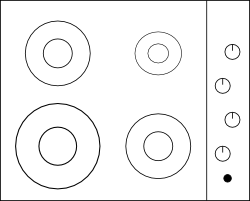Usability aspects of gas cookers
Published by Martin Kleppmann on 20 Jul 2007.
In this first article of the “power-off” series, I shed light on how we interact with low-tech
equipment – in this case, a kitchen stove. Considering that this device has only five knobs and no
electronics, it exhibits some surprising usability problems!
It’s Friday today, and since everybody
likes to slow down and take a step back from their work on Fridays, I will designate Friday to be
the power-off day in the Yes/No/Cancel magazine. It’s the day to switch off the computer and
look at things beyond it. As a computing professional, you occasionally forget about the real world
around you!
(Ironically, I’m still using my computer to write this article and you are using yours
to read it. So it’s hardly sticking to the spirit of “power-off”… but how about this: If you
want to really go for the whole non-electronic experience, give me your address and I’ll post you
the power-off article every Friday. Yes, on paper. How about that? Shocking, eh?)
Today’s topic is
the gas cooker at my home in Cambridge. And no, that’s not such a lame topic as you may think. This
is a device which I interact with pretty much every day, and it is therefore important that I feel
comfortable using
it.

Here is a photo of it – click it for a
larger picture. (I specially cleaned the cooker for this photo!) Very simple device: four hobs, one
knob to control each of them, and a button to trigger an electric spark which ignites the gas. What
could possibly be wrong with it?
My main problem with this cooker is that I never know which of the
four knobs controls which of the hobs. Ok, the front two knobs are for the front two hobs and the
rear two knobs are for the rear two hobs. But amongst these, which is which?
The only way of
knowing is to look at the tiny diagram beside each knob. And the diagram is inconveniently placed
such that it is hidden behind the knob if you are standing in front of the cooker! You therefore
have to lean over in order to see the label. I generally cannot be bothered to do this, so I just
try one of the two possibilities at random. And I generally get it wrong. And I get annoyed with the
cooker. Call me lazy, call me a slow learner, the end effect is still that I’m annoyed. (Hey, I cook
for myself from basic ingredients, I can’t be that lazy.)
The solution would be to arrange the
knobs in such a fashion that it is immediately clear which one controls which of the hobs. The
easiest way of doing that is to arrange them in a square, rather than in a straight line; however
that might be impractical as the cooker would have to be wider. So this is my suggestion, an
arrangement which is unambiguous but requires hardly any additional
space:

(Comments on whether it is more aesthetically pleasing are welcome.)

I’ve not finished
yet. The next thing I want to mention is a bizarre feature which seems to be common to gas cookers.
(I grew up with electric cookers, so this is a bit new to me.) Here is a picture of one of the
knobs. The arrow points to the right, which is its “off” setting. To turn on the gas, you turn the
knob anticlockwise. Two things I find
bizarre:
- In all other devices I can think of, turning the knob as far as possible
anticlockwise turns it off (the "leftmost" position). Here you need to go as far as possible
clockwise.
- When you gradually turn the knob away from the "off" position, you suddenly get
the maximum flow of gas; then as you turn it further, it gradually decreases again. The small flame
is furthest away from the "off" position, not closest as you may expect.
I’d be grateful
for any explanation of why gas cookers work this way. My hypothesis had been that it’s good to get a
strong flow of gas first thing after turning on, so that the spark will cause it to ignite quickly.
Only today when taking the photo did I notice the little spark symbol next to the little flame. This
suggests that you’re actually supposed to turn the knob all the way round to the little flame for
ignition – that completely messes up my theory. Any other ideas?
I must say though, the strange
behaviour of the knob doesn’t irritate me, as I’ve got used to that. The arrangement of the knobs
does though. And in two weeks I’ll be moving house, so I’m going to have to start all over again
getting to know my cooker.
If you found this post useful, please
support me on Patreon
so that I can write more like it!
To get notified when I write something new,
follow me on Bluesky or
Mastodon,
or enter your email address:
I won't give your address to anyone else, won't send you any spam, and you can unsubscribe at any time.



